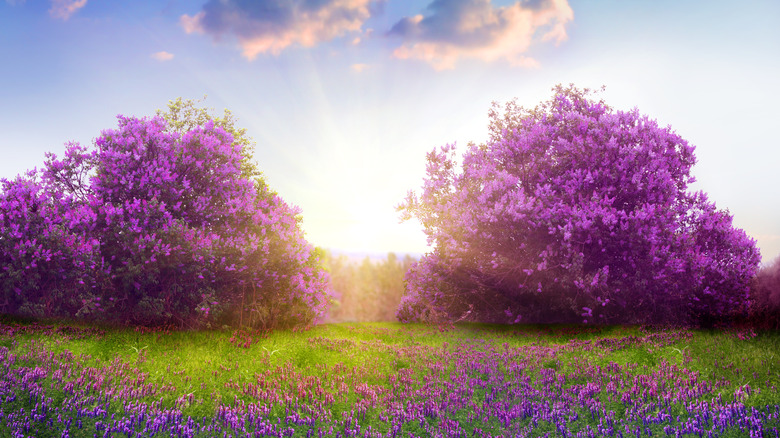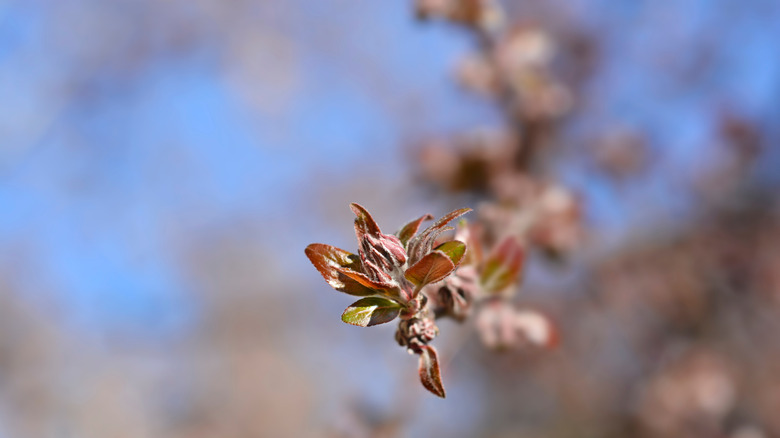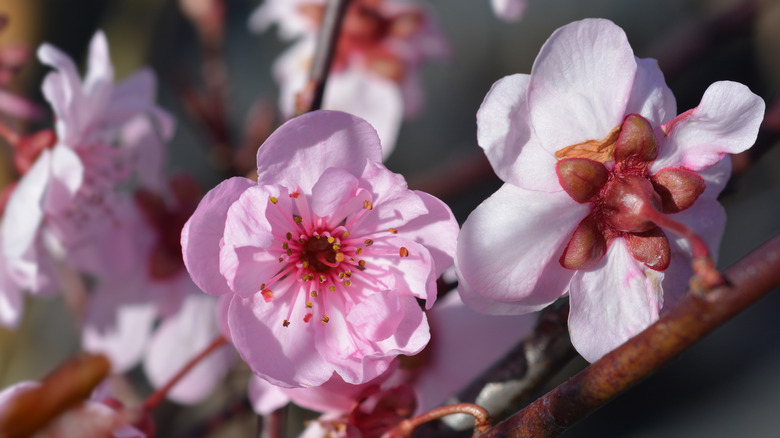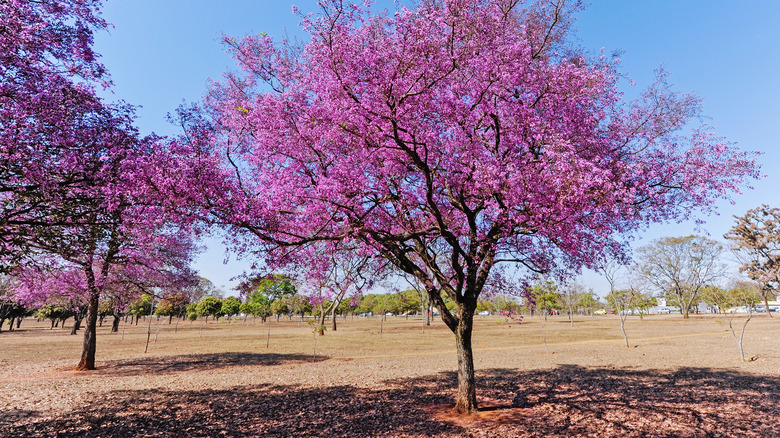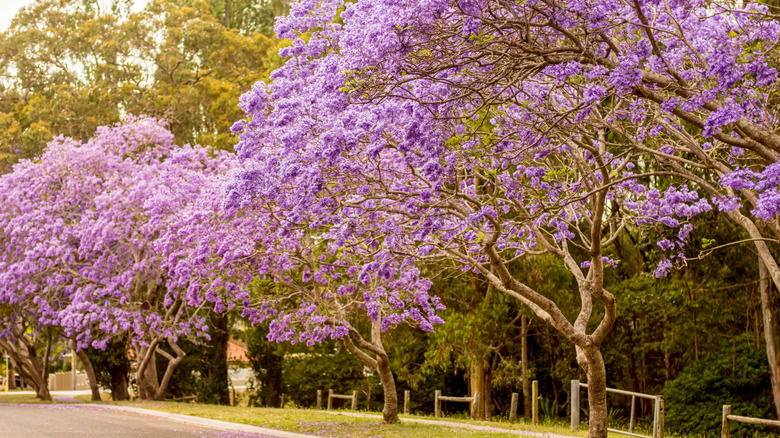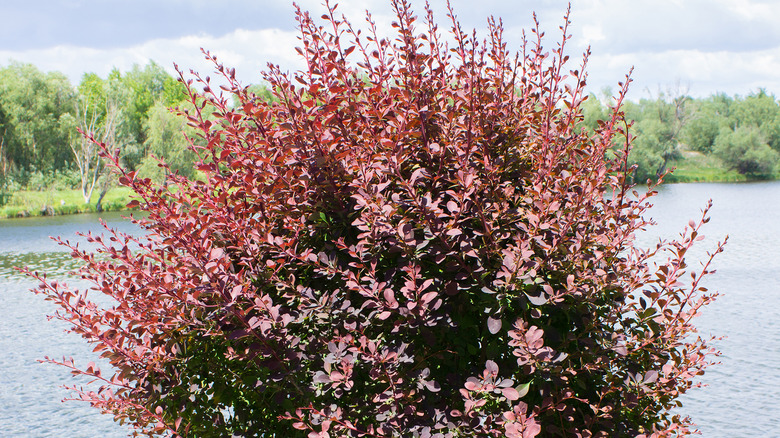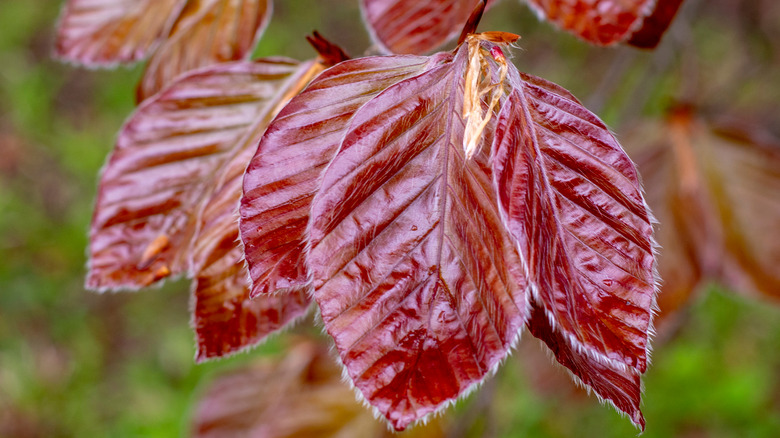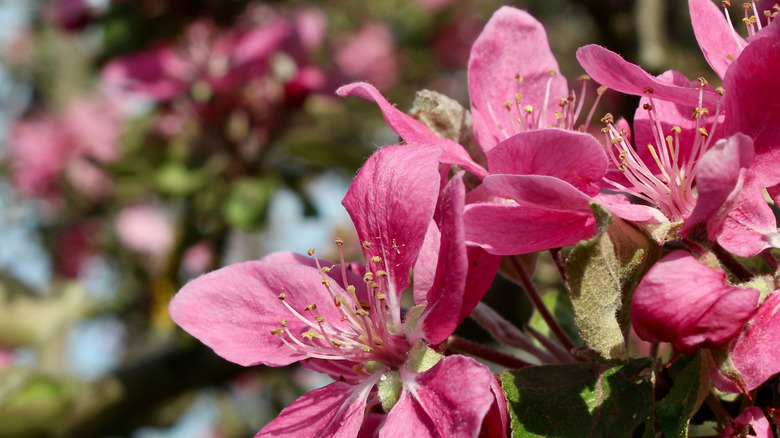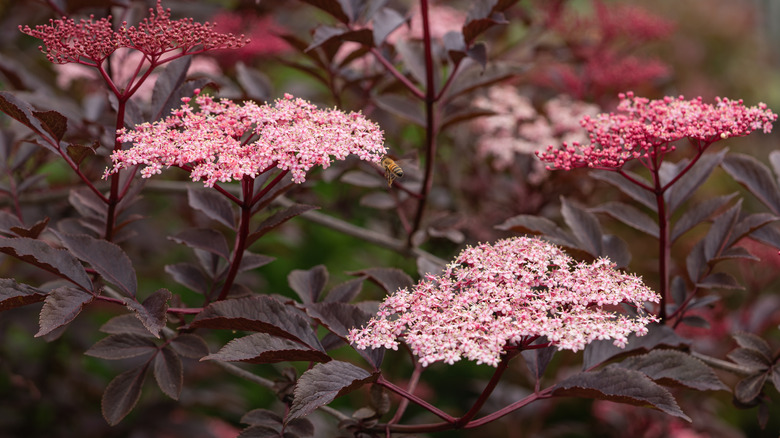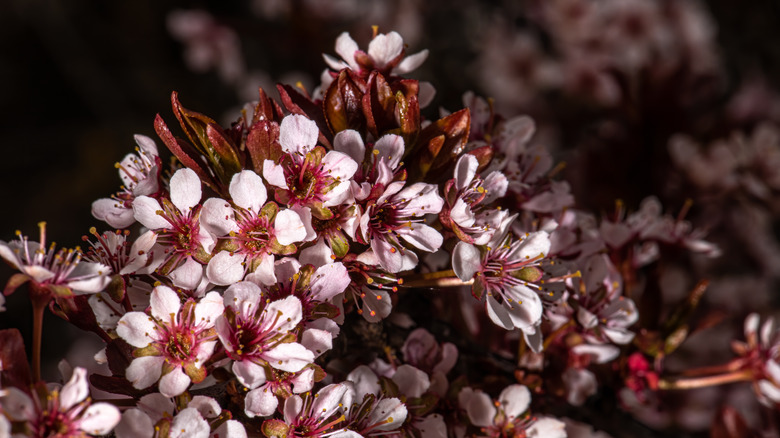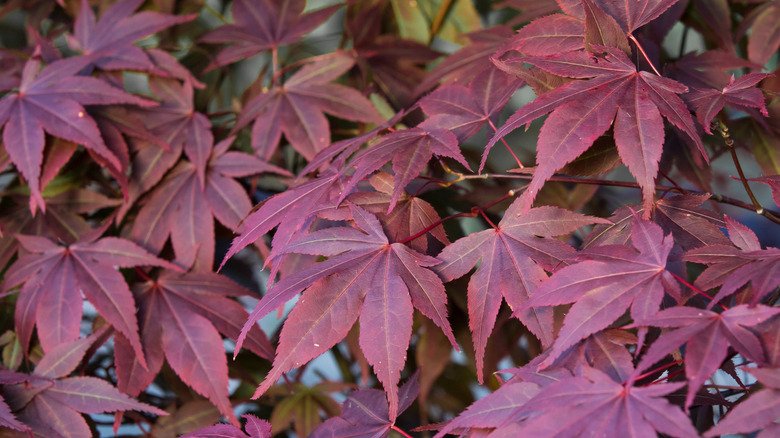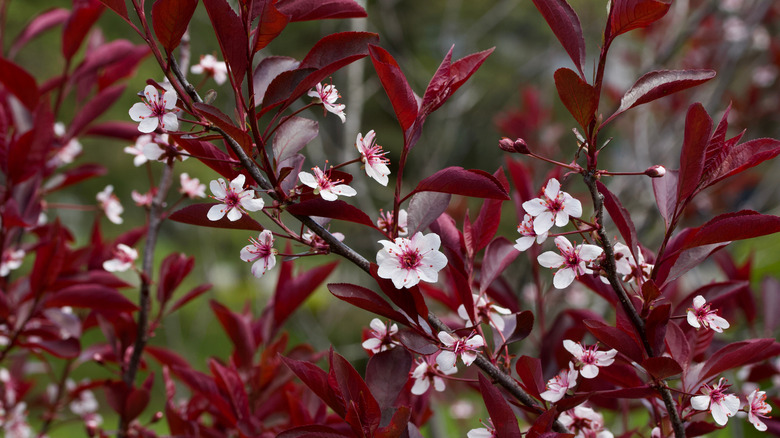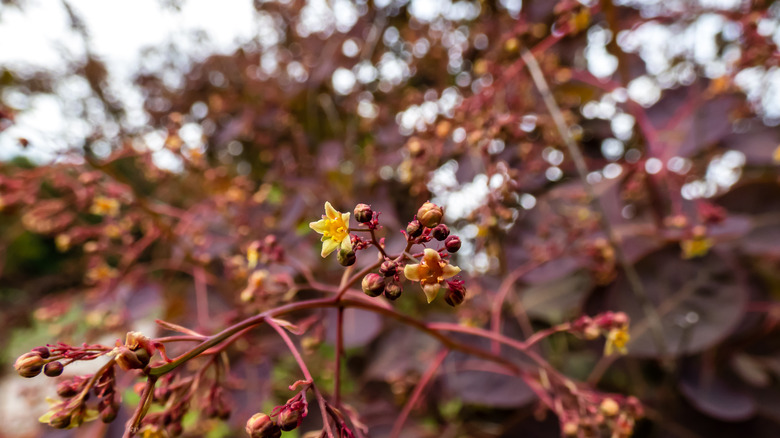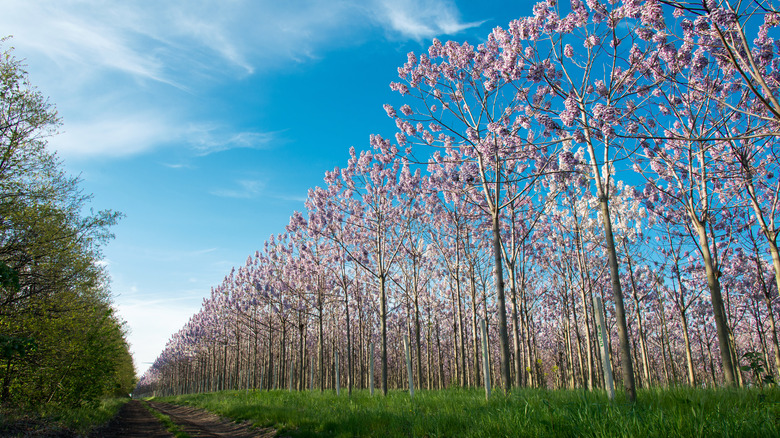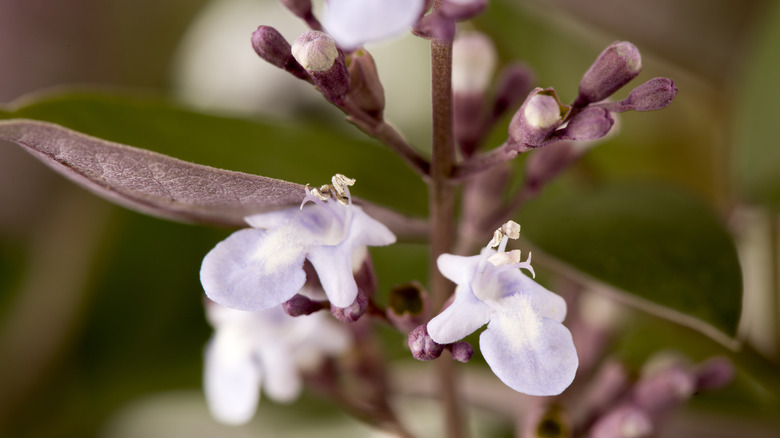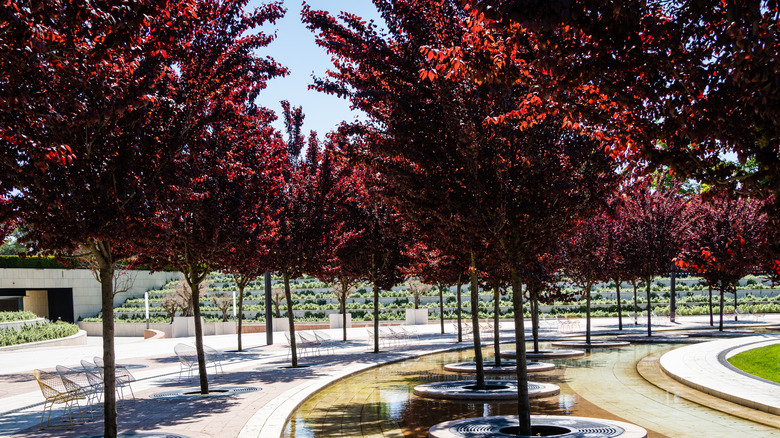15 Beautiful Trees With Purple Leaves
If you love trees with purple leaves, then you'll be happy to hear that those woody, perennial plants come in a variety of shapes and sizes. They impress with striking shades of purple foliage, abundant blooms, and occasionally, scores of edible fruit. We love purple-leafed trees for many reasons, but how they introduce contrast to gardens, landscapes, and planting schemes wins our hearts every time. We also love how some of these trees change colors throughout the season to keep your residential scenery fresh and vibrant.
If you want to enjoy the endless benefits of planting purple-leafed trees, you'll have to learn how to take care of them. Generally speaking, newly-planted trees require frequent watering, an ideal soil type, and mulch to retain moisture and regulate temperatures, Alpine Tree says. If you take the aforementioned steps and more, you'll have healthy trees growing 7 to 10 feet annually. Let's dive into the wonderful world of purple-leafed trees.
1. Red-silver crabapple
If you're looking to plant a semi-sweeping, deciduous tree, you can't do much better than red-silver crabapple (Malus 'Red Silver'). It's a spreading cultivar best known for producing handsome foliage and edible purplish-red fruit. Garden Design describes its leaves as dense, fragrant, and bronzy-purple with silver hairs.
Bloom Season: Mid to late spring
USDA Growing Zone: 4 to 8
Growing Conditions: Full sun
Soil Type: All types; normal to moist
Size: 15 to 25 feet tall, 10 to 20 feet wide
2. Blireiana plum
What we have here is blireiana plum (Prunus x blireiana), a cross between the Japanese apricot and the purple-leaved plum, according to North Carolina State University. Blireiana plum is one of the most beautiful purple-leaf trees. It stands out for its abundant clusters of double pink flowers, and its leaves that change colors from purple to green.
Bloom Season: Spring
USDA Growing Zone: 5 to 8
Growing Conditions: Full sun
Soil Type: Well-draining
Size: 10 to 20 feet tall, 10 to 15 feet wide
3. Crepe myrtle
Crepe myrtle (Lagerstroemia indica) has a wide native range, including southeast Asia and northern Australia. It's a multi-stemmed, small tree that thrives in dry and hot places that aren't suitable for most greenery. Take advantage of crepe myrtle's resilience and plant it in the hard-to-fill areas of your garden or landscape, per Missouri Botanical Garden. For best results, choose a bright, sunny spot.
Bloom Season: Summer to fall
USDA Growing Zone: 6 to 9
Growing Conditions: Full sun
Soil Type: Well-draining, moist
Size: 6 to 25 feet tall, 6 to 20 feet wide
4. Blue jacaranda
Beautiful trees with purple leaves like the blue jacaranda (Jacaranda mimosifolia) deserve a spot on every residential landscape because they're so breathtaking! Despite its name, it produces bright, lavender-purple flowers and fragrant, fern-like leaves. Blue jacaranda's branches take a lot of space, so choose your planting spot wisely, Gardening Know How encourages.
Bloom Season: Spring and summer
USDA Growing Zone: 9 to 11
Growing Conditions: Full sun
Soil Type: Moist, well-draining, sandy
Size: Up to 60 feet tall, similar spread
5. Helmond pillar
Home gardeners and landscapers desire helmond pillar (Berberis thunbergii) for its hardiness and deep purplish-red foliage, notes SF Gate. As the purple-leafed variety of barberries, helmond pillars make quite the dazzling display, especially alongside evergreen trees. They have thorns, so you can also maintain them as dense hedges to provide some level of security.
Bloom Season: Spring
USDA Growing Zone: 5 to 9
Growing Conditions: Full to partial sun
Soil Type: Well-draining
Size: Up to 5 feet tall, similar spread
6. Copper beech
Copper beech (Fagus sylvatica purpurea) is a large, deciduous shade tree that produces burgundy leaves, edible fruits, and yellow-green flowers. As with a few other beautiful trees with purple leaves, its foliage transforms into a striking copper color in the fall, Organic Plant Care points out. Pro tip: Prevent overcrowding by planting a smaller copper beech tree instead of purchasing a mature one.
Bloom Season: Spring
USDA Growing Zone: 4 to 7
Growing Conditions: Full sun
Soil Type: Moist, well-draining
Size: 60 to 80 feet tall, 40 to 60 feet wide
7. Profusion crabapple
An excellent way to add a splash of color to your neighborhood is to plant profusion crabapple (Malus 'Profusion') in your yard. It's purple-leafed and bears brilliant purple-red flowers that soften into a cloud of vibrant purple pinks. We love that it is low maintenance, disease-resistant, and perfect for small yards, according to Nature Hills Nursery.
Bloom Season: Spring
USDA Growing Zone: 4 to 8
Growing Conditions: Full sun
Soil Type: Well-draining, adaptable
Size: 20 to 30 feet tall, 15 to 25 feet wide
8. Black elderberry
Rainy Side Gardeners lists the elder blackberry tree (Sambucus nigra 'Purpurea') as one of the most beautiful trees with purple leaves. Black elderberries start as moderately-fast growing, broadleaf, deciduous shrubs that can reach 20 feet in height. If you care for your tree well and water it frequently, you should have a huge berry harvest in the second or third year.
Bloom Season: Late spring to early summer
USDA Growing Zone: 6 to 8
Growing Conditions: Full sun to partial shade
Soil Type: Fertile, moist, well-draining
Size: Up to 20 feet tall, similar spread
9. Cherry plum
Raise your guests' curiosity with the cherry plum (Prunus cerasifera 'Newport'), a popular ornamental landscape tree. It has a striking presence and boasts glossy, dark purple twigs and leaves. Gardenia notes that the cherry plum tree has transformative leaves. They are bronze-purple in the spring, a darkish red-purple in the summer, and red during the fall.
Bloom Season: Spring
USDA Growing Zone: 2-8
Growing Conditions: Full sun
Soil Type: Moist, moderately fertile, well-draining
Size: 15 to 20 feet tall, 13 to 19 feet wide
10. Japanese maple
The Japanese maple (Acer palmatum) is a purple leaf tree that comes in many varieties. It's native to eastern Mongolia, North Korea, southeast Russia, and South Korea. Japanese maple is a woody, deciduous shrub to small tree that produces colorful leaves that resemble an open hand with outstretched fingers, per Yale Nature Walk.
Bloom Season: Spring to fall
USDA Growing Zone: 5 to 9
Growing Conditions: Full sun to partial sun
Soil Type: Moist, slightly acidic, well-draining
Size: 10 to 25 feet tall, 8 to 12 feet wide
11. Purple-leaf sand cherry
Purple-leaf sand cherry (Prunus × cistena) is a cross between Prunus pumila and Prunus cerasifera. As a hybrid of Prunus, it's resilient and produces vibrant, reddish-purple foliage under direct sunlight. The only downside to planting this tree is that it has a short life span of less than a decade, writes Missouri Botanical Garden.
Bloom Season: Spring
USDA Growing Zone: 2 to 8
Growing Conditions: Full sun
Soil Type: All types, moist, well-draining
Size: 6 to 10 feet tall, 5 to 8 feet wide
12. Royal purple smoketree
Of course, we had to include the royal purple smoke tree (Cotinus coggygria) in our list of beautiful trees with purple leaves. Monrovia describes it as a dramatic, loose-spreading shrub or small tree that bears pinkish-purple foliage in the summer and scarlet-red leaves in the fall. It's primarily used to create large accents in landscapes.
Bloom Season: Spring to summer
USDA Growing Zone: 4 to 8
Growing Conditions: Full sun, light pruning
Soil Type: Medium moisture, well-draining
Size: 10 to 15 feet tall, 15 to 20 feet wide
13. Royal empress
Fun fact: The royal empress tree (Paulownia tomentosa) is one of the fastest-growing shade trees in the world, per Gardening Know How. Due to its size, some countries harvest it for lumber and carpentry purposes. It has a non-aggressive root system that tolerates drought extremely well. Pro tip: You'll want to plant it on a large landscape to prevent overcrowding.
Bloom Season: Spring
USDA Growing Zone: 7 to 10
Growing Conditions: Full sun
Soil Type: Humus-based loam, well-draining
Size: 30 to 40 feet tall, 30 to 40 feet wide
14. Chaste tree
Not only is this a beautiful tree, but the chaste tree (Vitex agnus-castus) possesses medicinal properties. According to the University of Rochester Medical Center, the China native can treat menstrual cycle-related pain and problems. Chaste trees are famous for changing leaf color throughout their blooming season.
Bloom Season: Mid-summer
USDA Growing Zone: 6 to 9
Growing Conditions: Full sun
Soil Type: Loose, well-draining soil
Size: 8 to 10 feet tall, 5 to 8 feet wide
15. Purple pony cherry
Purple pony cherry (Prunus cerasifera) is the perfect dwarf tree to grow on your property. According to Backyard Gardener, they are most common on Japanese landscapes, but you can plant them to make an extravagant statement in your garden. Purple pony cherry trees produce pale pink flowers and burgundy leaves that maintain color all season.
Bloom Season: Spring
USDA Growing Zone: 5 to 9
Growing Conditions: Full sun to partial shade
Soil Type: Loamy, well-draining
Size: 10 to 12 feet high, similar spread
